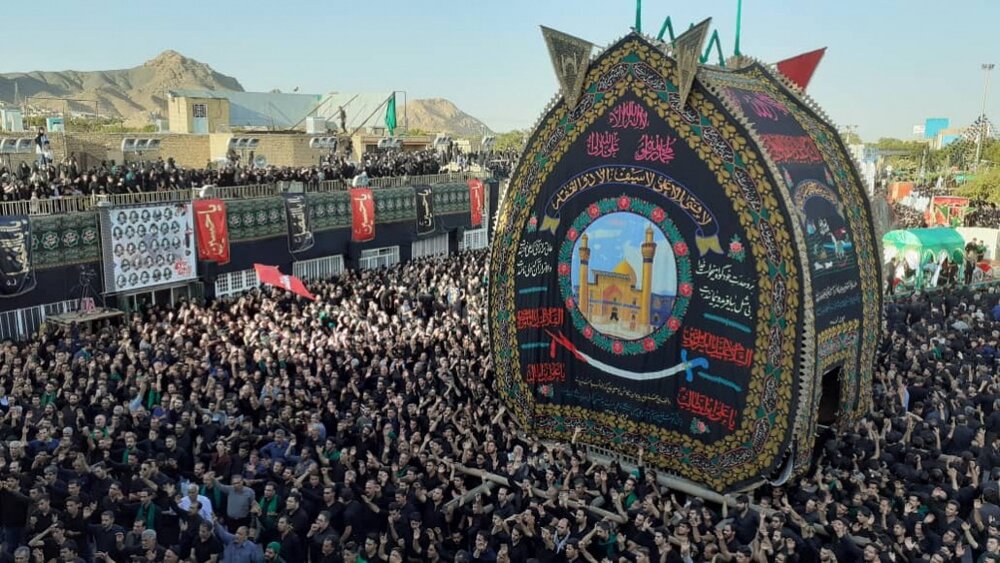Yazd: a prime destination for spiritual tourism

TEHRAN—Apart from its wonderful natural and cultural sites, Yazd province has long been a prime destination for spiritual tourism in the lunar month of Muharram.
It is the time when thousands of locals eagerly commemorate the martyrdom anniversary of Imam Hussein (AS) and his loyal companions, slain in 680 CE at Karbala in modern-day Iraq.
Holidaymakers may attend mourning ceremonies, such as Nakhl-Gardani or Nakhl-Bardari, which is a symbolic representation of the Imam's coffin, resembling an Imam’s funeral; Tazieh, a passionate play inspired by historical and religious narrations; and Sineh-Zani [beating the chest].
Over the past decade, Yazd has been a major destination for foreign tourists on the ninth and the tenth days of Muharram (Tasu’a and Ashura) when the mourning ceremonies reach their climax.
The ceremonies are traditionally attended by many domestic travelers as well as people from France, Germany, Belgium, China, Turkey, Russia, the Netherlands, Brazil, Switzerland, Italy, New Zealand, Spain, the UK, the Czech Republic, Hungary, Slovenia, Japan, Taiwan, Hong Kong, Romania, Australia, and Thailand, to name a few.
Referring to Yazd as a destination for religious tourism, its deputy tourism chief on Monday said the province has been famed as a hub for spiritual tourism, CHTN reported.
Last month, the provincial tourism chief Ahmad Akhoundi said: “Yazd is set to host more than one hundred special religious rituals during Muharram and Safar to commemorate the slaying of Imam Hussein (AS), a grandson of the Prophet Mohammed (PBUP).”
“This year, special mourning programs are planned to be held to get (foreign) tourists familiar with religious ceremonies held during these two months, especially on the days of Tasu’a and Ashura,” the official added.
From a theological approach, religious rituals are perhaps a recreation of collective memories that help to shape what is known as collective identity, an essential foundation for a sense of belonging. One such ritual is the mourning ceremony. Rich with symbolism, most of which have historical values, these ceremonies are a platform where communal beliefs and ideas about life and death are acknowledged and as people unite in grief and hope for consolation, they search for new meanings of life and reevaluate and confirm the foundation of their beliefs.
Muharram and the following month, Safar (which includes a commemoration of the aftermath of Karbala) are a period of lamentation for Muslims. War and fighting are prohibited during Muharram and festivities like weddings and birthdays are usually postponed to more appropriate days. People generally wear black out of respect or at least avoid wearing very bright colors.
They say the core meaning of Muharram is beyond such mere bereavement and commemoration of the past. Karbala was an actual and metaphorical venue where the Truth confronted the Lie, where justice spoke vibrant and audible in the face of prejudice, and where courage, passion, and devotion preceded attachment, worldliness, and obstinacy.
The saga is narrated to tell us that compared to the Pyrrhic and momentary victory of injustice, integrity and honesty will always stand the test of time as today the life of Imam Hussein (AS) is honored by millions across the world while the account of his enemies is nearly lost in oblivion. The story also lives to tell us that the majority is not always right. Even if the army of Truth is small, it still is magnanimous in what it stands for.
In July 2017, the historical core of Yazd was named a UNESCO World Heritage. Yazd is regularly referred to as a delightful place to stay, or a “don’t miss” destination by almost all of its visitors. The city is full of mudbrick houses that are equipped with innovative badgirs (wind catchers), atmospheric alleyways, and many Islamic and Iranian monuments that shape its eye-catching city landscape.
Cultural heritage experts believe that Yazd is a living testimony to the intelligent use of limited available resources in the desert for survival. Water is brought to the city by the qanat system. Each district of the city is built on a qanat and has a communal center. Furthermore, the use of earth in buildings includes walls and roofs through the construction of vaults and domes. Houses are built with courtyards below ground level, serving underground areas. Wind-catchers, courtyards, and thick earthen walls create a pleasant microclimate.
The historical core of Yazd is chockful of mudbrick houses, bazaars, public bathhouses, water cisterns, mosques, synagogues, Zoroastrian temples, and centuries-old gardens. From the divine point of view, the city enjoys the peaceful coexistence of three religions: Islam, Judaism, and Zoroastrianism.
Yazd is home to numerous qanats which have supplied water to agricultural and permanent settlements for thousands of years. The man-carved underground qanat system relies on snow-fed streams flowing down the foothills of surrounding mountains. The earliest water supply to Yazd is estimated to date from the Sassanid era (224 to 651 CE). However, many others have been continually repaired and used over time, and most surviving Ab-Anbars (traditional mudbrick cisterns) can be today traced to the late Safavid and Qajar periods.
Yazd Water Museum is a must-see destination for the ones interested to know about the brave men who built such underground aqueducts in the past. Located in a restored mansion with a visible qanat running underneath, the museum offers its visitors a fascinating glimpse into the hidden world of qanats through a series of photographs, exhibits, and architectural drawings. It represents nearly 2000 years of unique irrigation structure that has been in operation, yet describes the drilling of mother wells and associated underground water networks stretched to the ancient city.
AFM
Leave a Comment